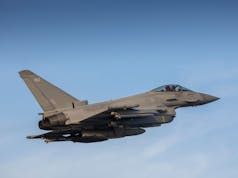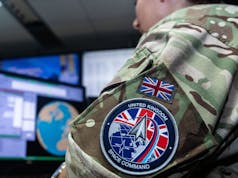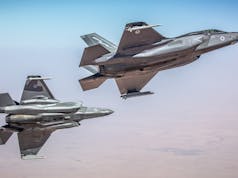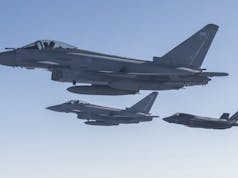The UK’s three RC-135 Rivet Joint electronic surveillance aircraft will benefit from an extension to the support arrangement with the US Government until 2035 in a deal worth £970 million.
The Ministry of Defence say that the agreement will continue to benefit from maintenance, spare parts, engineering support, technical data and access to capability updates.
“Airseeker support is provided by the unique venture between the United States Air Force and the UK MOD – known as the Rivet Joint Cooperative Programme – which was due to expire in 2025 and will now continue until the UK out of service date in 2035.”
Defence Minister Jeremy Quin said:
“The Rivet Joint Cooperative Programme is a fantastic example of the UK/US special relationship and the support for our Airseeker fleet has been extended for a further decade. With a commitment to invest almost £1 billion, this agreement will ensure that we, and our allies, can benefit from the aircraft’s impressive surveillance capability for years to come.”
The aircraft works by using its sensors to detect, identify and geolocate signals throughout the electromagnetic spectrum. The mission crew can then forward gathered information in a variety of formats to a wide range of consumers via Rivet Joint’s extensive communications suite.
The aircraft is in the air frequently, undertaking various surveillance missions around Europe and the Middle East.
“To ensure the aircraft continue to receive support until 2035, the existing Memorandum of Understanding with the US was extended following negotiations between the US Department of Defense and the UK MOD. Under the new MOU, the MOD have committed to investing £970 million in the programme over the next 14 years.”
Signing the MOU on behalf of the UK, Sir Simon Bollom, CEO of Defence Equipment & Support (DE&S) said:
“Extending Airseeker support reaffirms the continuing cooperation between the UK and US in this important Defence capability area. I am delighted that Airseeker will continue to receive world-class sustainment and follow-on development support right up until the current UK out of service date in 2035.”
The aircraft are operated out of RAF Waddington by the Royal Air Force’s 51 Squadron as part of the Intelligence, Surveillance, Target Acquisition and Reconnaissance Force led by the ISTAR Force Commander, Air Commodore Nick Hay.













At this point the RC-135 is just a bunch of antennas pretending to be an airplane.
By saying which you reveal no knowledge at all as to the sophistication of this type of equipment.
Which is probably just as well.
Actually it was my attempt at humor regarding the amount of antennas on the aircraft. And I’m very familiar with the aircraft and it’s lineage.
Not every comment is an attack on her majesty’s armed forces.
Sorry, I didn’t mean to be snippy.
I was awaiting comments about airframe age etc
lol, It’s all good SB. It’s sometimes hard to read tone in this format. It was more a compliment to the platform when you look at the amount of antennas that they somehow got to fit on this aircraft. I also don’t think it’s going away anytime soon as it’s way too valuable.
It will be interesting to see what replaces it.
As I understand it the USAF has no firm plan about how it would go about actually replacing the RC-135 family. They plan to keep the planes flying until at least 2050.
By 2050 the whole concept will be totally out of date given how fast electronics and computers are moving.
2035 sounds like a lot more reasonable EOL to me.
Mind you SB the thick end of a £billion contribution should underpin quite a large amount of electronics and computer upgrades, even at inflated US MIC pricing. But that might not be the only issue. Given their gentle lifestyle at high altitudes the airframes should be OK but parts? They were robbing parts off an active 135 to keep a special flight running at Mildenhall 3 years ago, it can only get worse. As to shrinking it into a smaller aircraft like a 737, there is lot of analogue needed that, for a variety of reasons, might not be shrinkable like digital is.
Good. 3 of these replaced the Signals intelligence version of Nimrod (Nimrod R1), which numbered 4 aircraft but I think one of crashed in Afghanistan. Very important capability which very few nations have,great that the US operates them in this country as well. I believe they also operate a Constant phoenix as well, a Nuclear explosion ‘sniffer’ plane. There also a dozen variants of the class, for varying missions but they were usually only 1 strong. I believe we operate the RC-135W Cobra Ball which is the one the US operates on the largest numbers as well. There acquistion was actually on time and budget, all being converted KC135 tankers.
I stand by to be corrected but isn’t the Cobra Ball the RC-135S, a platform optimised for collecting intelligence on ballistic missile launches? I’m pretty sure the RC-135W Rivet Joints that the RAF operates are the standard SIGINT type, which does seem to also be the most numerous RC-135 variant in USAF service.
Agree. I thought Cobra Ball complements the radar they have in the Aleutians that monitor ICBM launches which land at Kamchatkha.
One of our gold plated capabilities.
Long may it continue.
The support chain for these assets is as interesting as the aircraft itself.
I wonder when the US/UK will change to a newer airframe, such as P-8, B737Max or A321XLR?
The USAF would never be allowed to buy Airbus even if it were the superior platform (as seen with MRTT). In reality airliners as base platforms are all pretty much of a muchness so I don’t see the UK insisting on spending money to integrate the sensors on a different platform to the US when we could instead just continue to limpet onto the US programme for R&D, build and support with all the associated cost savings with no appreciable change in capability.
The US Navy may be leading the way. Combat aircraft mag, Sept 2021, had a small item on 3X USN P-8 with bogus BuNo 169564, 169012, 169323. said to be ELINT & SIGINT.
I recall that a number of years ago the RAF was going to drop the very silly computer-generated US name (Rivet Joint) and adopt a much better name. Clearly that did not happen.
You do have to wonder about the value of randomly selected code names when reality and the project collide IRL – suppose it still sounds good and is of value for the newer really secret stuff.
I thought they were already known as Seeker in RAF service (in keeping with Sentry, Sentinel and Shadow)?
Have recently been reading Rowland White’s latest book about The Falklands War when the predeceasing Nimrod R1 was secretly deployed to Chile and flew a number of missions to soak up a lot of very useful Argentine signals chatter. An absolutely crucial asset in any confrontation both then and now.